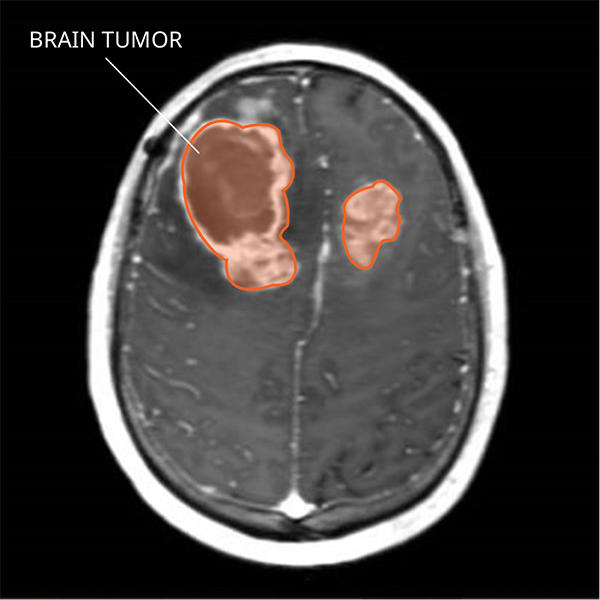Gliosarcoma is a primary central nervous system (CNS) tumor. This means it begins in the brain or spinal cord. Gliosarcoma is a rare type of glioma.
To get an accurate diagnosis, a piece of tumor tissue will be removed during surgery, if possible. A neuropathologist should then review the tumor tissue.
What Are the Grades of Gliosarcomas?
Primary CNS tumors are graded based on a tumor tissue analysis performed by a neuropathologist. Gliosarcomas are all classified as grade 4 (also written as grade IV) tumors. This means they are malignant (cancerous) and fast-growing. They are further described as either “primary” or “secondary”:
- Primary: The tumor is diagnosed from the first surgery or biopsy.
- Secondary: The tumor forms from a pre-existing glioma, usually after radiation treatment.
What Do Gliosarcomas Look like on an MRI?
Gliosarcomas usually appear as a single tumor with vague borders. The tumors may occur near the surface of the brain and be attached to the covering of the brain. The tumor often brightens with contrast on a magnetic resonance imaging (MRI) scan. Many tumors can occur in different areas of the CNS. They usually have some swelling around them.
What Causes Gliosarcomas?
Cancer is a genetic disease—that is, it is caused by certain changes to genes that control the way our cells function. Genes may be mutated (changed) in many types of cancer, which can increase the growth and spread of cancer cells. The cause of most gliosarcomas is not known. However, previous exposure to radiation and certain genetic changes that can be passed down through families have been linked to a higher chance of developing glioblastomas.
Where Do Gliosarcomas Form?
Gliosarcomas are commonly found along the surface of the brain but can also form in the spinal cord. They arise from glial cells, the supportive cells in the brain. Gliosarcomas develop with two different characteristics. Some resemble astrocytes, a star-shaped glial cell and the most abundant cell in the brain. Other gliosarcomas resemble connective tissue cells called sarcomas.
Do Gliosarcomas Spread?
Gliosarcomas can spread to other areas of the CNS through cerebrospinal fluid (CSF). However, they generally do not spread outside the CNS to other organs.
What Are the Symptoms of a Gliosarcoma?
Gliosarcoma symptoms depend on the tumor’s location. Here are some possible symptoms that can occur:
- Headaches
- Seizures
- Thinking or memory difficulties
- Weakness
- Numbness
- Problems with balance and movement
Who Is Diagnosed with a Gliosarcoma?
Gliosarcomas can occur at any age but are most common in people between age 40 and 60. Accurate statistics on the number of people diagnosed per year, the number of people living with the disease, and the survival rates cannot be calculated because of changes in tumor classification. Gliosarcoma is not considered a separate tumor type per the 2021 World Health Organization (WHO) Classification of Tumors of the Central Nervous System. Instead, it is a morphological variant of glioblastoma.
Gliosarcomas are thought to represent about 2 percent of glioblastomas. They can be identified by their special morphologic features and a genetic profile that is similar—but not identical—to that of glioblastoma.
What Is the Prognosis of a Gliosarcoma?
The likely outcome of the disease or chance of recovery is called prognosis. Prognosis is based on tumor grade, location, tumor type, extent of tumor spread, genetic findings, the patient’s age, and tumor remaining after surgery (if surgery is possible). There are many factors that can affect prognosis. If you want to understand your prognosis, talk to your doctor.
What Are the Treatment Options for Gliosarcomas?
The first treatment for a gliosarcoma is surgery, if possible. The goal of surgery is to obtain tissue to determine the tumor type and remove as much tumor as possible without causing more symptoms.
Gliosarcomas are aggressive, so most people receive additional treatments. These treatments may include radiation, chemotherapy, or clinical trials. Clinical trials test new chemotherapy, targeted therapy, or immunotherapy drugs. Treatments are decided by the patient’s health care team based on the patient’s age, remaining tumor after surgery, tumor type, and tumor location.
Open Clinical Studies for Gliosarcomas
- PLX038 in CNS Tumors
- Immune Monitoring for Patients with Gliosarcoma and Glioblastoma
- Immune Checkpoint Inhibitor Nivolumab for Patients with Rare CNS Cancers
- ONC206 for Patients with Rare CNS Neoplasms
Learn More
- Video: Clinical Trial Tests Nivolumab for Patients with Rare Brain and Spine Cancers
- Statistical Report Highlights Key Trends in Adolescents and Young Adults with Brain Tumors
- Modifying a Chemotherapy Drug Offers Hope to People with Rare Brain and Spine Tumors
- Smart Wearables Show Promise for Tracking Sleep Patterns in Brain Tumor Patients
- Read our NCI-CONNECTions Blog for current news and information on brain and spine tumors
Referrals
NCI-CONNECT doctors and nurses work with you and your primary doctor to collaborate on a comprehensive care plan that treats your brain or spine tumor. They will also help you cope with the physical and emotional aspects of your diagnosis. Learn about requesting a consultation >

